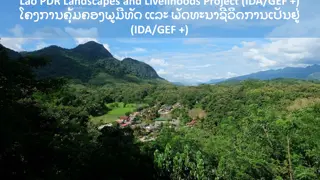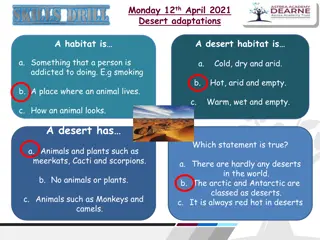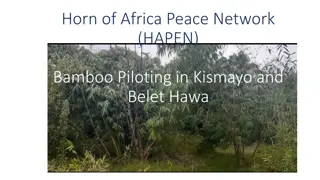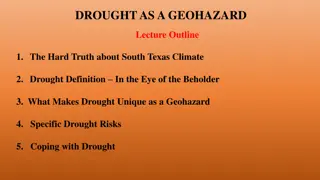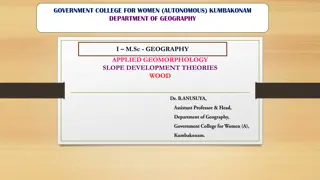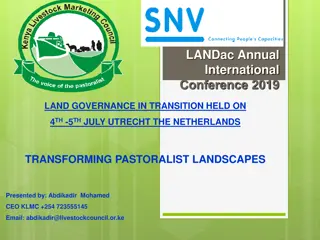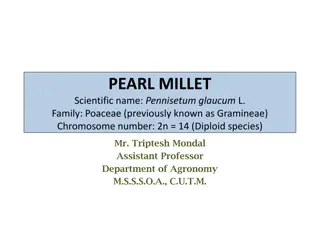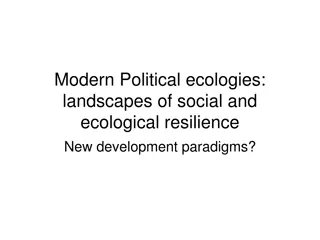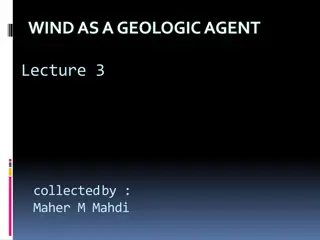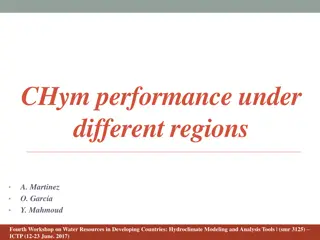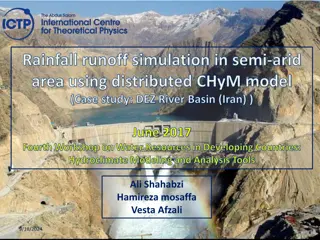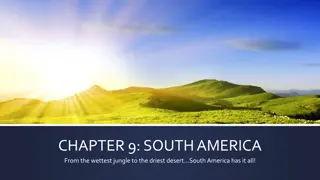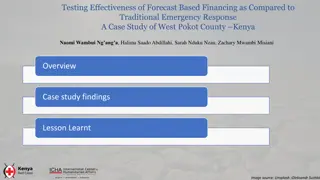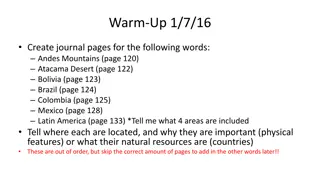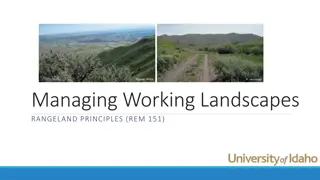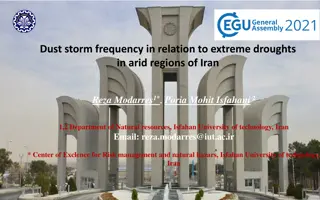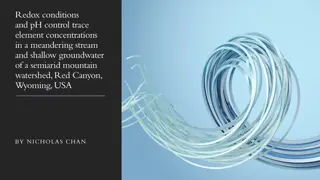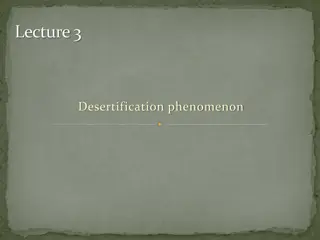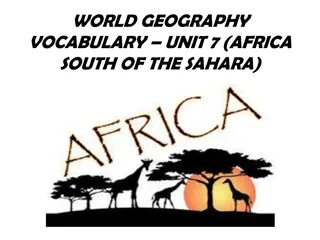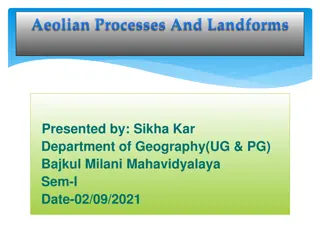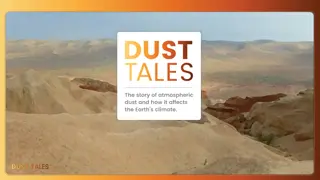Discover the Rich Culture and Diverse Landscapes of India
India, officially known as the Republic of India, is a diverse and culturally rich country located in South Asia. With vibrant traditions, a rich history, and stunning landscapes, India offers a mesmerizing experience for travelers. From the majestic forts and palaces of Jaipur to the spiritual ritu
3 views • 17 slides
Discovering Oman: A Comparison of Landscapes
Explore the unique physical features of Oman, from its rocky deserts to towering mountains and scenic coastlines. Contrasting with the UK, discover how Oman's natural landscapes offer a fascinating glimpse into its geological diversity.
7 views • 11 slides
Understanding Alluvial Fans: Formation, Characteristics, and Morphology
Alluvial fans are cone-shaped landforms formed by streams carrying sediments from mountains onto plains. They are prominent in arid to semi-arid regions and vary in size from a few meters to over 150 kilometers. The different zones of an alluvial fan, including the fan apex and distal fan, display d
5 views • 9 slides
Vocabulary and Conversation Practice in Australia
Enhance your vocabulary with words related to landscapes and wildlife while exploring a conversation between Mark and Phong about their holiday adventures in Australia. Dive into learning about island life, sunsets, landscapes, and penguins in a fun and engaging setting.
1 views • 18 slides
Strategic Platform for Sustainable Landscapes in Lao PDR
The Lao PDR Landscapes and Livelihoods Project aims to establish a strategic platform for sustainable landscapes to address the fragmentation of investments, institutions, incentives, and information. By enhancing coordination and efficiency, the project aligns with key government priorities related
3 views • 9 slides
Essential Tips for Planting Woody Plants in Brunswick County Landscapes
Explore important considerations for selecting, buying, and planting woody plants in Brunswick County landscapes, including information on tree roots, plant stems, container vs. balled and burlapped plants, and key steps for successful planting. Learn about proper tree and shrub planting techniques
0 views • 12 slides
Aeolian Landforms: Shaping Earth's Surface Through Wind Action
Geomorphic processes, including aeolian processes, play a significant role in modifying the earth's surface. This article delves into how wind erosion and deposition create unique landforms such as ventifacts and yardangs. Understanding the transportation methods and topographic effects of wind eros
0 views • 22 slides
Climate and Climatic Regions of Pakistan
Pakistan exhibits diverse climatic regions ranging from sub-tropical continental mountains to arid desert plateaus. Factors like altitude, latitude, and distance from the sea greatly influence the country's climate. The country experiences weather conditions such as temperature variations, rainfall
0 views • 14 slides
Desert Adaptations: Animals and Habitat Survival
Habitats play a crucial role in the survival of animals, especially in harsh environments like deserts. Explore the unique adaptations of animals like camels and learn how they are perfectly suited to thrive in hot, arid conditions. Understanding these adaptations is key to appreciating the diversit
0 views • 16 slides
Harnessing Bamboo for Sustainable Agriculture in Somalia
The Horn of Africa Peace Network (HAPEN) is piloting bamboo cultivation in Kismayo and Belet Hawa to combat desertification and promote sustainable agriculture. Bamboo, a versatile plant, offers a renewable resource that can thrive in various climates, including the arid regions of Somalia. The init
0 views • 5 slides
Understanding Drought as a Geohazard in South Texas
South Texas faces chronic water scarcity due to its semi-arid climate, leading to frequent droughts. This lecture explores the unique characteristics of drought as a geohazard, its specific risks, and the societal impacts it can cause, including direct meteorological and hydrological effects, as wel
0 views • 13 slides
Slope Development Theories in Applied Geomorphology
Slopes are formed through different processes as described by Wood's slope development theories, such as the Four Unit Slope Model and the 9-Unit Slope Model. These models illustrate various manifestations of slope profiles based on factors like rock composition and water movement. Different slope t
0 views • 10 slides
Aeolian Landforms and Processes: A Geographical Study by Ms. Annu
Geomorphic processes are crucial in shaping the Earth's surface, with Aeolian processes driven by wind erosion, transportation, and deposition. This study explores the topographic effects of wind erosion, transportation methods, and the formation of Aeolian landforms like ventifacts and yardangs. Th
0 views • 22 slides
Challenges Faced in Isiolo County, Kenya's Arid Region
Isiolo County in Kenya, characterized by arid and semi-arid lands, faces challenges related to fragile ecosystems, climate change impact, land use competition, breakdown of traditional resource systems, and tribal conflicts. This poses threats to the nomadic pastoral way of life and sustainable land
0 views • 10 slides
Pearl Millet - Overview, Economic Importance, and Cultivation
Pearl millet (Pennisetum glaucum L.) is a vital coarse grain crop, known for its drought tolerance and nutritional value. Also called bajra, it serves as staple food, poultry feed, and cattle fodder. Originating from Africa, pearl millet is widely cultivated in semi-arid regions of India, Africa, an
7 views • 22 slides
Exploring Modern Political Ecologies and Resilience Landscapes
Dive into the intersection of social, ecological, and political dynamics shaping modern landscapes, with a focus on remittance economies, land use, governance, and sustainability. Analyze the impact of diverse socio-environmental organizations on local, regional, and global landscapes, recognizing t
0 views • 17 slides
Wind as a Geologic Agent in Shaping Landscapes
Wind has played a significant role in shaping landscapes during times of drier climates, being a key geologic agent impacting erosion and deposition processes. The global wind system, driven by factors such as heating from the sun and the rotation of the Earth, creates convection currents that circu
0 views • 31 slides
Enhancing Restoration Success with Seed Pellets: A Study on Predicting Germination in Arid Environments
Ecological restoration in arid lands often faces challenges with seeding projects. This study explores using seed pellets to predict germination success by matching seed traits with pellet characteristics. The hypotheses focus on seed size and species comparison to improve restoration practices.
0 views • 13 slides
Analysis of CHyM Model Performance in Different Regions
The study evaluates the performance of the CHyM model in humid and arid regions, specifically focusing on Tropical South America and Central America. Through analyzing simulated values, seasonal behavior, and response to ENSO phases, the study provides insights into water resource management in thes
0 views • 16 slides
Understanding Climate Classification Systems
Climatology explores the classification of climates based on vegetation distribution, average temperatures, precipitation patterns, and seasonal variations. This system categorizes climates into groups like tropical, dry, mild temperate, continental, and polar. Each group further delineates specific
0 views • 8 slides
Integrated Drought Risk Management in Latin America and the Caribbean
Managing water resources in arid and semi-arid regions of Latin America and the Caribbean involves addressing climate risks through integrated drought risk management. Tools such as National Drought Observatories, Latin American Flood and Drought Monitor, and the Latin American Drought Atlas aid in
0 views • 14 slides
Rainfall-Runoff Simulation in Semi-Arid Area Using Distributed CHyM Model: DEZ River Basin Study
This case study delves into the simulation of rainfall-runoff using the CHyM model in the semi-arid area of the DEZ River Basin in Iran. The study focuses on water resources management, flood control, and forecasting of flood discharge parameters, emphasizing the importance of accurate modeling for
0 views • 22 slides
The Noble Camel: General Information, Physical Characteristics, Habitats, Behaviors, and Interesting Facts
The Camelus Dromedarius, known as the camel, has distinctive characteristics such as its hump(s) for storing fat and surviving in deserts and semi-arid grasslands. Camels can endure extreme heat, lack of water, and can go months without drinking due to their unique adaptations. They are herbivores,
0 views • 6 slides
Understanding Ecosystems: Climate, Biomes, and Management
Explore the relationship between climate and biomes on a global scale, focusing on hot semi-arid grasslands and one other biome. Learn about the physical processes linking living and non-living components in ecosystems, such as nutrient cycles and food webs. Discover how small-scale ecosystems in th
0 views • 4 slides
Exploring the Diverse Landscapes of South America
South America boasts a varied topography, from the majestic Andes mountains to the expansive Amazon River basin. Its rugged landscapes have both attracted and isolated communities over time. Discover the high plains of the Altiplano, the arid beauty of Patagonia, and the lush grasslands of the llano
0 views • 19 slides
Effectiveness of Forecast-Based Financing in Emergency Response: A Case Study of West Pokot County, Kenya
Extreme weather conditions are increasingly impacting regions worldwide, especially arid areas like West Pokot County, Kenya. To address these challenges, the Kenya Red Cross Society implemented a Forecast-Based Financing (FBF) system in partnership with the FBF technical working group. By testing t
0 views • 14 slides
Understanding Deserts and Desertification: Factors and Consequences
Delve into the intricate mechanisms behind the formation of deserts and desertification. Explore how low and high-pressure zones, monsoons, and global air pressure contribute to the creation of arid landscapes. Discover the impact of air currents, humidity, and the Equator on the development of dese
0 views • 15 slides
Adaptations of Xerophytes in Different Habitats
Xerophytes, plants adapted to dry habitats, possess specific adaptations to prevent excessive water loss such as sunken stomata, presence of hairs, thick waxy cuticle, and rolled leaves. These adaptations help xerophytes thrive in arid conditions, maintaining humid air around stomata and maximizing
0 views • 13 slides
Discovering South America: Landscapes and Resources
Explore the diverse regions of South America, from the majestic Andes Mountains to the arid Atacama Desert, the vibrant countries of Bolivia, Brazil, Colombia, and Mexico, and the rich tapestry of Latin America. Learn about the physical features and natural resources that make these areas unique and
0 views • 19 slides
Effective Strategies for Managing Working Landscapes: Challenges and Approaches
Planning and managing landscapes across different land ownerships involve various challenges and require collaborative resource management. By emphasizing outcomes and utilizing adaptive management approaches, diverse groups can come together to manage resources effectively. This involves balancing
0 views • 10 slides
Fascinating Desert Animals and the Resilient Camel
Discover the intriguing world of desert animals, including the swift mongoose known for hunting in groups, and the remarkable camel, capable of surviving long periods without water. Learn about the unique characteristics and survival techniques of these creatures in the arid desert environment.
0 views • 4 slides
Investigating Dust Storm Frequency and Extreme Drought Relationship in Arid Regions of Iran
This research by Reza Modarres and Poria Mohit Isfahani from Isfahan University of Technology explores the temporal changes in dust storm frequency in arid regions of Iran, examining how drought impacts the frequency in changing environments and the relation between extreme droughts and dust storm o
0 views • 14 slides
Redox Conditions and pH Control in a Mountain Watershed: Study in Red Canyon, Wyoming, USA
Exploring redox conditions and trace element concentrations in a semi-arid mountain watershed, this study in Red Canyon, Wyoming, delves into the impact of oxic surface water and anoxic groundwater on trace element cycling. The investigation aims to enhance understanding of seasonal variabilities, f
0 views • 11 slides
Understanding Deserts and Desertification: Lecture Insights by Maher M. Mahdi
Delve into the world of deserts and desertification with valuable insights collected by Maher M. Mahdi. Explore definitions of deserts, steppe regions, and semi-arid climates. Learn about the dryness ratio, distinguishing factors between true deserts and semi-deserts, and Budyko-Lettau dryness ratio
0 views • 22 slides
Water Harvesting Techniques in Rainfed Agriculture & Watershed Management
Water harvesting plays a crucial role in rainfed agriculture by collecting and storing runoff water for irrigation in arid and semi-arid regions. Mr. Anil Swami, an assistant professor, discusses the importance of water harvesting techniques, including runoff farming and rainwater harvesting. He emp
0 views • 13 slides
Understanding Desertification: A Global Environmental Challenge
Desertification is a pressing issue affecting over a billion people globally, with drylands covering a significant portion of the Earth's surface. This phenomenon leads to the degradation of ecosystems and poses severe challenges for inhabitants of arid regions. Major deserts like the Sahara and Ara
1 views • 21 slides
Life in Deserts: Harsh Yet Vibrant Ecosystems
Deserts, the driest and hottest places on Earth, host a surprising variety of animals that have adapted to scarce water sources and scorching heat. From gerbils seeking shade in underground burrows to beetles collecting water droplets, these creatures demonstrate remarkable survival strategies. Desp
0 views • 4 slides
Geography of Africa South of the Sahara - Physical Features, Climate, and Economy
Explore the physical geography of Africa south of the Sahara, including features like fault lines, savannas, deltas, and escarpments. Learn about the effects of harmful actions on the environment like desertification. Discover the diverse climate regions, from wet tropical rainforests to arid desert
0 views • 23 slides
Understanding Aeolian Processes and Landforms
Aeolian processes are crucial in arid and semi-arid regions, involving erosion, transportation, and deposition by wind. Factors like wind velocity, grain size, rock composition, and vegetation influence erosion. Different types of wind erosion include deflation, abrasion, and attrition. The transpor
0 views • 18 slides
Unveiling the World of Dust: Origins, Movements, and Historical Perspectives
Dust, a fine-grained sediment, originates mainly from arid regions like deserts, with the Sahara being a major source. Carried by winds over vast distances, dust plays a crucial role in shaping landscapes and climate. The amount of dust in the atmosphere has fluctuated throughout Earth's history, wi
0 views • 12 slides




